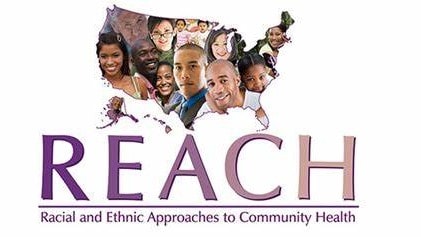Key points
- Racial and Ethnic Approaches to Community Health (REACH) is a CDC-funded program to reduce racial and ethnic health disparities or gaps.
- REACH program recipients plan and carry out local, culturally appropriate programs.
- REACH programs use proven strategies to help improve health, prevent chronic diseases, and reduce health disparities.

2024 REACH Lark Award Challenge
Apply today
Why it is important to end health gaps
All people should be able to reach their full health potential. However, health gaps exist among racial and ethnic minority groups. These groups may have higher rates of disease, early death, and health care costs, and lower quality of life.
For example, from 2017 to March 2020, the rate of obesity was higher among Black (50%) and Hispanic (46%) adults than White adults (41%). Also, diabetes prevalence was:
- 21% among Hispanic adults.
- 19% among Black adults.
- 18% among Asian adults.
- 12% among White adults.
Priorities
REACH aims to improve health, prevent chronic diseases, and reduce health disparities among racial and ethnic populations with the highest risk, or burden, of chronic disease. Such diseases include high blood pressure, heart disease, type 2 diabetes, and obesity. The program's goal is to make healthy eating and active living more accessible and affordable to priority populations.
REACH addresses health disparities using culturally appropriate programs designed for different racial and ethnic minority groups: African American or Black, Hispanic, Latino, Asian American, Native Hawaiian, Pacific Islander, American Indian, and Alaska Native.
Since 1999, REACH recipients have used community-based, participatory approaches to identify, develop, and share effective strategies for addressing health disparities. See:
- REACH 2023 (current)
- Past REACH programs
Accomplishments
Reducing racial and ethnic health gaps is complex. REACH recipients work with their partners to help remove barriers to health linked to race or ethnicity, education, income, location, or other social factors.
Read examples from:
- Society for Public Health Education: REACH
- Society for Public Health Education: REACH Urban Communities
- 2022 Lark Galloway-Gilliam Award for Advancing Health Equity
- 2020 Lark Galloway-Gilliam Award for Advancing Health Equity
How it's funded
REACH awards funds state and local health departments, tribes, universities, and community-based organizations. Recipients use these funds to build strong partnerships to guide and support the program's work. Along with funding, CDC provides expert support to REACH recipients.
